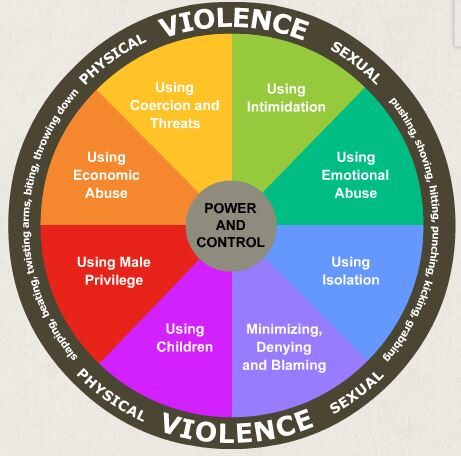
Domestic Violence refers to violence and abuse between partners or family members in an intimate relationship DV includes not only physical violence but also psychological, economic and sexual abuse. DV is rooted in “the Power and Control dynamics” as bellow.

Types of DV
There are several types of domestic violence, each of which can have serious consequences for the victim.
Physical Violence; This is an act of direct physical violence against a partner or family member, such as punching, kicking, pulling, pushing or throwing objects. Examples; blows, choking, attacks with weapons.
Psychological Violence (psychological abuse); This is an act of harming another person through words or attitudes that diminish their sense of self-worth. This includes threats, insults, neglect and isolating behaviour. Examples; hurting the other person with words such as ‘no one loves you’ or ‘you are nothing’.
Economic Violence; This is behaviour used as a means of restricting the victim’s financial freedom and controlling the other person. This includes controlling their income, forcing them to quit their job, not giving them money to live on, etc. Examples; complete control over the family finances and not allowing the victim to spend money.
Sexual Violence; This is forcing someone to perform sexual acts without their consent or sexually abusing them. Sexual violence can also occur between spouses or partners. Examples; forcing someone to have sex without their consent, refusing contraception.
Social Violence; This is an act of social isolation of the victim. Restrict contact with friends and family or prohibit them from going out. E.g.: imposes restrictions such as ‘don’t see your friends’ or ‘don’t let you see your parents’.
Impact of domestic violence
Domestic violence not only causes serious physical, mental and emotional damage to the victim, but also has long-term social and economic consequences. Victims often suffer from psychological problems such as fear, loss of self-worth, depression, anxiety and post-traumatic stress disorder (PTSD). Domestic violence can also have serious effects on children, traumatising them as witnesses and negatively affecting their future development.
Cycle of DV
DV often follows a specific pattern described as the ‘DV cycle’. This includes the following phases

Tension-forming phase; the perpetrator feels frustrated and dissatisfied, and the victim feels tension in response.
Violence explosion phase; tension reaches a peak and the perpetrator engages in violent behaviour.
Honeymoon phase; after the violence, the perpetrator apologises and tries to repair the relationship by showing kindness to the victim and keeping promises. This period is temporary and often returns to the tension-forming phase again.
Escape from DV and support
Social support and legal protection are essential for victims of domestic violence to escape safely. In many countries and regions, hotlines, shelters and legal support are provided for victims of domestic violence. The following supports are important to help victims break the cycle of domestic violence.

Securing safe haven; providing shelters and temporary shelters where victims can safely escape.
Legal support; legal assistance to obtain restraining orders or protection orders against DV perpetrators.
Counselling and psychological support; counselling and treatment to help victims recover emotionally.
Social support networks; friends, family and community support for victims to prevent isolation.
Legal responses
In many countries, there is a legal response to domestic violence, with laws providing criminal penalties for perpetrators, protection for victims or emergency shelter DV is recognised as a criminal offence that should be addressed by society as a whole, rather than simply as a domestic problem.
Conclusion.
Domestic violence is a serious social problem that requires ongoing support for victims; in order to protect and support victims of domestic violence, it is important that society as a whole raises awareness of domestic violence and establishes appropriate support systems. Addressing the underlying causes of DV and challenging social gender inequalities and dominant cultures are also important steps in DV prevention.













